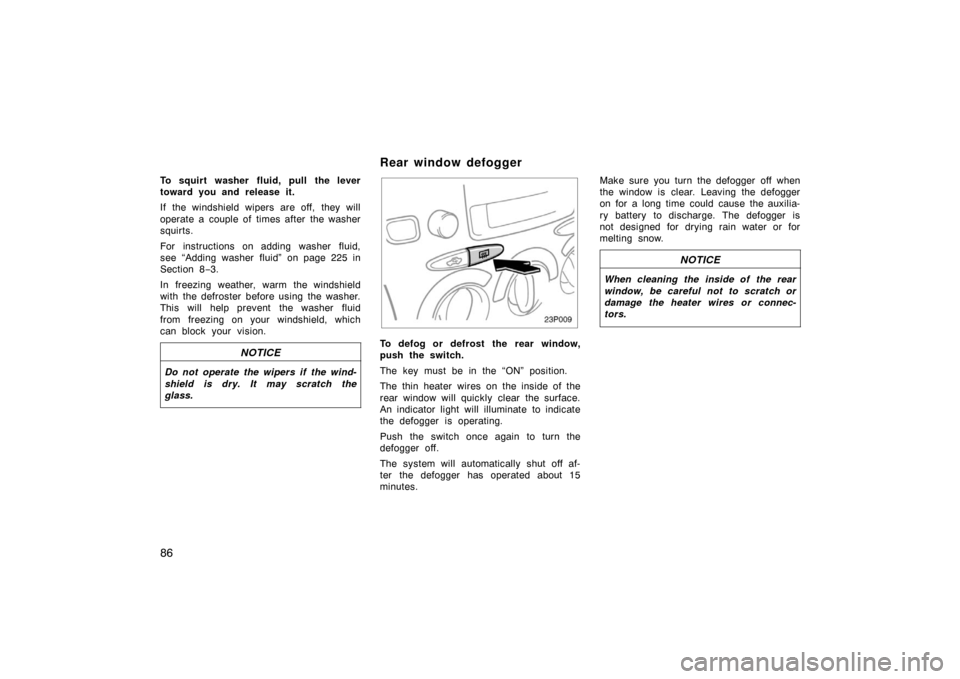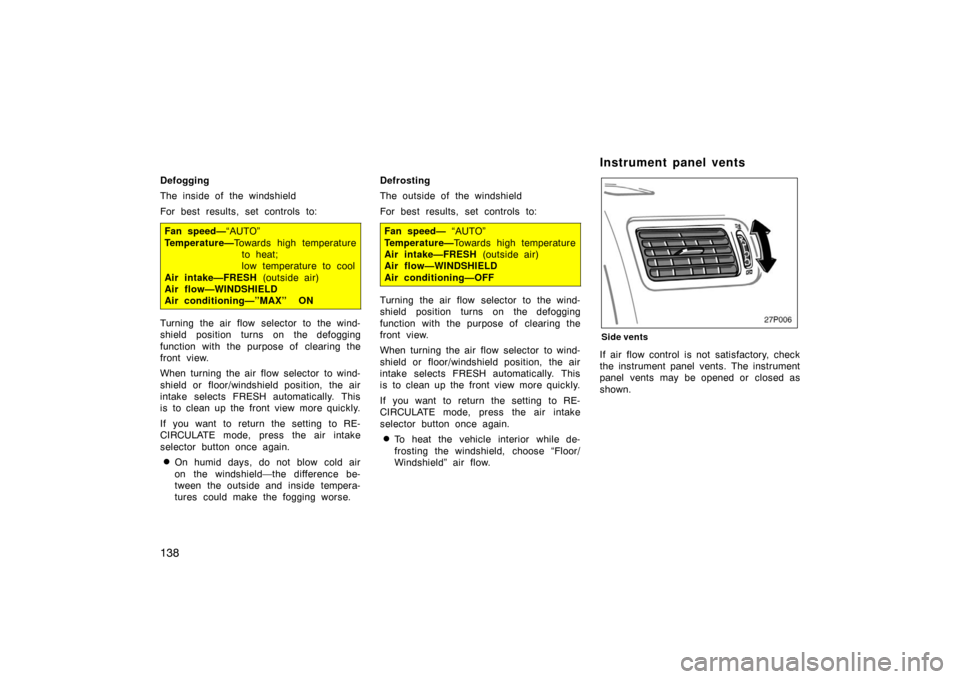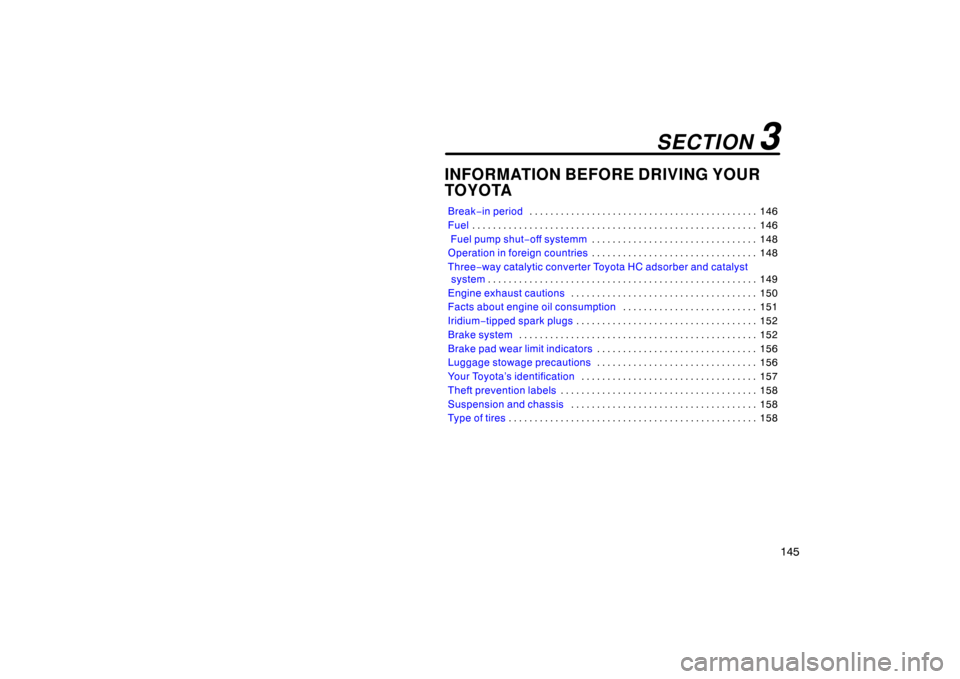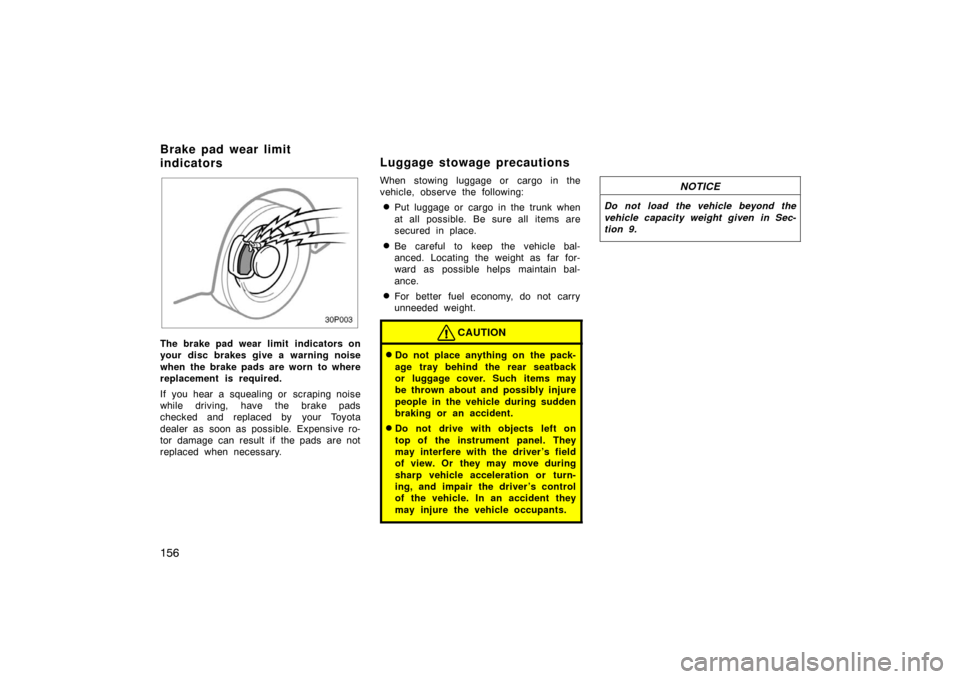Page 10 of 258

10
If an accident occurs
�Pull your Toyota off the road,
put the selector lever in “P”
and remove the ignition key.
�In order to avoid personal in-
juries, do not touch any high
voltage wirings and their con-
nectors, and high voltage
parts (inverter unit, hybrid ve-
hicle battery, etc.).
�If some exposed electric wir-
ings are protruding inside or
outside of your Toyota, an
electric shock may occur.
Never touch the electric wir-
ings.
�If fluid leaks or gets in some
parts of the vehicle, never
touch it because it may be
electrolyte (strong alkali) from
the hybrid vehicle battery. If
it gets into your skin or eyes,
wash off immediately with a
large amount of water, if pos-
sible, boric acid solution, and
get immediate medical atten-
tion in order to help avoid
serious injury.
�If a vehicle fire occurs, extin-
guish it using a fire extin-
guisher for the exclusive use
on electric fires. Or, use a
large amount of water to pre-
vent flammable gas from be-
ing generated from the batter-
ies.
�When your Toyota needs to
be towed, do it with the front
wheels raised. For details on
towing, see “If your vehicle
needs to be towed” on page
180 in Section 5.
Page 29 of 258
16
�When your vehicle needs to be
towed, do it with the front wheels
or all four wheels raised. If the
front wheels are on the ground
when towing, the electric motor
may continue to generate electricity
which could cause leakage of elec-
tricity and a fire depending on the
degree of damage. See “If your ve-
hicle needs to be towed” on page
180 in Section 5.
Page 44 of 258
31
21p024a
To open the trunk lid from the outside,
insert the key and turn it clockwise.
See “Luggage stowage precautions” on
page 156 in Section 3 for precautions to
observe in loading luggage.
To close the trunk lid, lower it and press
down on it. After closing the trunk lid, try
pulling it up to make sure it is securely
closed.
CAUTION
Keep the trunk lid closed while driv-
ing. This not only keeps the luggage
from being thrown out, but also pre-
vents exhaust gases from entering
the vehicle.
�Always lock the trunk lid and all
doors, and keep away the vehicle
keys out of children’s reaches.
�Never leave children unattended in
the vehicle. Unsupervised children
may lock themselves in the vehicle
or trunk and suffer serious injuries
or death.
21p025a
To open the trunk lid from the driver’s
seat, pull up on the lock release lever.
Trunk lid——Lock release lever
Page 99 of 258

86
To squirt washer fluid, pull the lever
toward you and release it.
If the windshield wipers are off, they will
operate a couple of times after the washer
squirts.
For instructions on adding washer fluid,
see “Adding washer fluid” on page 225 in
Section 8−3.
In freezing weather, warm the windshield
with the defroster before using the washer.
This will help prevent the washer fluid
from freezing on your windshield, which
can block your vision.
NOTICE
Do not operate the wipers if the wind-
shield is dry. It may scratch the
glass.
23p009
To defog or defrost the rear window,
push the switch.
The key must be in the “ON” position.
The thin heater wires on the inside of the
rear window will quickly clear the surface.
An indicator light will illuminate to indicate
the defogger is operating.
Push the switch once again to turn the
defogger off.
The system will automatically shut off af-
ter the defogger has operated about 15
minutes. Make sure you turn the defogger off when
the window is clear. Leaving the defogger
on for a long time could cause the auxilia-
ry battery to discharge. The defogger is
not designed for drying rain water or for
melting snow.
NOTICE
When cleaning the inside of the rear
window, be careful not to scratch or
damage the heater wires or connec-
tors.
Rear window defogger
Page 151 of 258

138
Defogging
The inside of the windshield
For best results, set controls to:
Fan speed—“AUTO”
Temperature— Towards high temperature
to heat;
low temperature to cool
Air intake—FRESH (outside air)
Air flow—WINDSHIELD
Air conditioning—”MAX” ON
Turning the air flow selector to the wind-
shield position turns on the defogging
function with the purpose of clearing the
front view.
When turning the air flow selector to wind-
shield or floor/windshield position, the air
intake selects FRESH automatically. This
is to clean up the front view more quickly.
If you want to return the setting to RE-
CIRCULATE mode, press the air intake
selector button once again.
�On humid days, do not blow cold air
on the windshield—the difference be-
tween the outside and inside tempera-
tures could make the fogging worse. Defrosting
The outside of the windshield
For best results, set controls to:
Fan speed—
“AUTO”
Temperature— Towards high temperature
Air intake—FRESH (outside air)
Air flow—WINDSHIELD
Air conditioning—OFF
Turning the air flow selector to the wind-
shield position turns on the defogging
function with the purpose of clearing the
front view.
When turning the air flow selector to wind-
shield or floor/windshield position, the air
intake selects FRESH automatically. This
is to clean up the front view more quickly.
If you want to return the setting to RE-
CIRCULATE mode, press the air intake
selector button once again.
�To heat the vehicle interior while de-
frosting the windshield, choose “Floor/
Windshield” air flow.
27p006
Side vents
If air flow control is not satisfactory, check
the instrument panel vents. The instrument
panel vents may be opened or closed as
shown.
Instrument panel vents
Page 158 of 258

145
INFORMATION BEFORE DRIVING YOUR
TOYOTA
Break−in period 146
. . . . . . . . . . . . . . . . . . . . . . . . . . . . . . . . . . . . .\
. . . . . . .
Fuel 146
. . . . . . . . . . . . . . . . . . . . . . . . . . . . . . . . . . . . \
. . . . . . . . . . . . . . . . . . .
Fuel pump shut −off systemm 148
. . . . . . . . . . . . . . . . . . . . . . . . . . . . . . . .
Operation in foreign countries 148
. . . . . . . . . . . . . . . . . . . . . . . . . . . . . . . .
Three −way catalytic converter Toyota HC adsorber and catalyst
system 149
. . . . . . . . . . . . . . . . . . . . . . . . . . . . . . . . . . . . \
. . . . . . . . . . . . . . . .
Engine exhaust cautions 150
. . . . . . . . . . . . . . . . . . . . . . . . . . . . . . . . . . . . \
Facts about engine oil consumption 151
. . . . . . . . . . . . . . . . . . . . . . . . . .
Iridium −tipped spark plugs 152
. . . . . . . . . . . . . . . . . . . . . . . . . . . . . . . . . . .
Brake system 152
. . . . . . . . . . . . . . . . . . . . . . . . . . . . . . . . . . . . \
. . . . . . . . . .
Brake pad wear limit indicators 156
. . . . . . . . . . . . . . . . . . . . . . . . . . . . . . .
Luggage stowage precautions 156
. . . . . . . . . . . . . . . . . . . . . . . . . . . . . . .
Your Toyota’s identification 157
. . . . . . . . . . . . . . . . . . . . . . . . . . . . . . . . . .
Theft prevention labels 158
. . . . . . . . . . . . . . . . . . . . . . . . . . . . . . . . . . . . \
. .
Suspension and chassis 158
. . . . . . . . . . . . . . . . . . . . . . . . . . . . . . . . . . . . \
Ty p e of tire s 158
. . . . . . . . . . . . . . . . . . . . . . . . . . . . . . . . . . . . \
. . . . . . . . . . . .
SECTION 3
Page 169 of 258

156
30p003
The brake pad wear limit indicators on
your disc brakes give a warning noise
when the brake pads are worn to where
replacement is required.
If you hear a squealing or scraping noise
while driving, have the brake pads
checked and replaced by your Toyota
dealer as soon as possible. Expensive ro-
tor damage can result if the pads are not
replaced when necessary.When stowing luggage or cargo in the
vehicle, observe the following:
�Put luggage or cargo in the trunk when
at all possible. Be sure all items are
secured in place.
�Be careful to keep the vehicle bal-
anced. Locating the weight as far for-
ward as possible helps maintain bal-
ance.
�For better fuel economy, do not carry
unneeded weight.
CAUTION
�Do not place anything on the pack-
age tray behind the rear seatback
or luggage cover. Such items may
be thrown about and possibly injure
people in the vehicle during sudden
braking or an accident.
�Do not drive with objects left on
top of the instrument panel. They
may interfere with the driver’s field
of view. Or they may move during
sharp vehicle acceleration or turn-
ing, and impair the driver’s control
of the vehicle. In an accident they
may injure the vehicle occupants.
NOTICE
Do not load the vehicle beyond the
vehicle capacity weight given in Sec-
tion 9.
Brake pad wear limit
indicators
Luggage stowage pr
ecautions
Page 174 of 258
161
STARTING AND DRIVING
Before starting the hybrid system162
. . . . . . . . . . . . . . . . . . . . . . . . . . . . .
How to start the hybrid system 162
. . . . . . . . . . . . . . . . . . . . . . . . . . . . . . .
Tips for driving in various conditionss 163
. . . . . . . . . . . . . . . . . . . . . . . . .
Winter driving tips 164
. . . . . . . . . . . . . . . . . . . . . . . . . . . . . . . . . . . . \
. . . . . .
Dinghy towing 165
. . . . . . . . . . . . . . . . . . . . . . . . . . . . . . . . . . . . \
. . . . . . . . . .
Trailer towing 165
. . . . . . . . . . . . . . . . . . . . . . . . . . . . . . . . . . . . \
. . . . . . . . . .
How to save fuel and make your vehicle last longer, too 166
. . . . . . . . .
SECTION 4